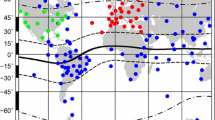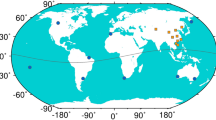Abstract
For low earth orbit satellite global positioning systems (GPS) receivers, ionospheric delay corrections from space-based augmentation system (SBAS) can be considered for real-time use. Due to the different total electron contents between ground and low altitude orbits, a scaling factor is required to adjust the ionospheric corrections. After an analysis of the scale factor determination with GPS data from the NASA/DLR gravity recovery and climate experiment satellite is conducted, evaluations of WAAS, MSAS, and EGNOS ionospheric correction accuracies are performed. In terms of the ionospheric correction error in 2012, SBAS outperforms GPS broadcast with the reduction of 42 %. This SBAS ionospheric correction accuracy shows a high level of correlation with solar flux F10.7.










Similar content being viewed by others
References
Bock H, Jäggi A, Dach R, Schaer S, Beutler G (2009) GPS single-frequency orbit determination for low earth orbiting satellites. Adv Space Res 43:783–791
Case K, Kruizinga G, Wu S (2010) GRACE level 1B data product user handbook, JPL Publication D-22027
Chao YC, Tasi Y-J, Walter T, Kee C, Enge P, Parkinson B (1995) An algorithm for inter-frequency bias calibration and application to WAAS ionosphere modeling. In: Proceedings ION GPS 1995, Institute of Navigation, Palm Springs, pp 639–646
Eurocontrol, GNSS Tools Team (2006) PEGASUS: Technical Notes on SBAS
Garcia-Fernandez M, Montenbruck O (2006) LEO satellite navigation errors and vertical total electron content in single-frequency GPS tracking. Radio Sci 41:RS5001
Hwang Y, Born GH (2005) Orbit determination strategy using single-frequency global-positioning-system data. J Spacecr Rocket 42(5):896–901
Kim J, Tapley BD (2002) Error analysis of a low–low satellite-to-satellite tracking mission. J Guid Control Dyn 25(6):1100–1106
Klobuchar JA (1996) Global positioning system: theory and applications. In: Ionospheric effects in GPS. AIAA Publications, Washington, pp 485–515
Lear WM (1987) GPS navigation for low-earth orbiting vehicles, NASA 87-FM-2, JSC-32031, rev. 1, Lyndon B. Johnson Space Cent., Houston, Tex
Montenbruck O (2003) Kinematic GPS positioning of LEO satellites using ionosphere-free single frequency measurements. Aerosp Sci Technol 7:396–405
Montenbruck O, Gill E (2002) Ionospheric correction for GPS tracking of LEO satellites. J Navig 55:293–304
RTCA (2001) Minimum operational performance standards for global positioning system/wide area augmentation system airborne equipment, DO-229D. Radio Technical Commission for Aeronautics (RTCA), Washington
Tancredi U, Renga A, Grassi M (2011) Ionospheric path delay models for spaceborne GPS receivers flying in formation with large baselines. Adv Space Res 48(3):507–520
Yang Y, Li Y, Dempster AG, Rizos C (2013) Ionospheric path delay modelling for spacecraft formation flying. In: International Global Navigation Satellite Systems Society Symposium 2013, Australia, paper 31
Yoon JC, Roh KM, Park ES, Moon BY, Choi KH, Lee JS, Lee BS, Kim J, Chang YK (2002) Orbit determination of spacecraft using Global Positioning System single frequency measurements. J Spacecr Rocket 39(5):796–801
Yue X, Schreiner WS, Hunt DC, Rocken C, Kuo YH (2011) Quantitative evaluation of the low earth orbit satellite based slant total electron. Space Weather 9:S09001
Yunck TP (1996) Orbit determination. In: Parkinson BW, Spilker JJ (eds) Global positioning system. Theory and applications. AIAA Publications, Washington, DC
Acknowledgments
This research was supported by the Space Core Technology Development Program funded by the Ministry of Science, ICT and Future Planning (NRF-2012M1A 3A3A02033484).
Author information
Authors and Affiliations
Corresponding author
Rights and permissions
About this article
Cite this article
Kim, J., Lee, Y.J. Using ionospheric corrections from the space-based augmentation systems for low earth orbiting satellites. GPS Solut 19, 423–431 (2015). https://doi.org/10.1007/s10291-014-0402-8
Received:
Accepted:
Published:
Issue Date:
DOI: https://doi.org/10.1007/s10291-014-0402-8




